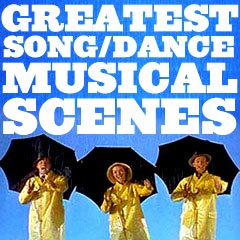
|
Musical Moments and Scenes P - 1 |
| P | ||||||||||||||||||||||||||
| Movie Title/Year and Scene Descriptions | ||||||||||||||||||||||||||
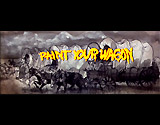
|
Paint Your Wagon (1969) When brought to the big screen by heavy-handed director Joshua Logan, Lerner and Loewe's western stage musical from 1951 (with adaptation by Paddy Chayefsky and additional tunes by Andre Previn), set during the 1849 California Gold Rush, was mostly criticized for its contrived love triangle plot and for featuring non-singers:
The musical also featured a rendition of one of the stage show's best songs - the most-often recognized and melancholy They Call the Wind Maria (pictured) sung by Rotten Luck Willie (Harve Presnell). Another lively song was The Gospel of No Name City (pictured), sung by a bearded religious Parson (Alan Dexter) to the townsfolk of the tent city that had sprung up due to the gold rush: ("...You wanna say where the vice is worser? Here it is! I mean, here it is! You wanna live life in the rottenest way? Here it is! Women and whiskey, night and day? Here it is! You wanna embrace the golden calf? Ankle, and thigh, and upper half? Here it is! I mean, here it is! No name city. No name city. The Lord don't like it here..."). |
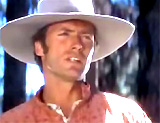   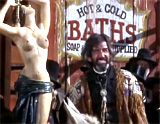
|
||||||||||||||||||||||||

|
The Pajama Game (1957) Stanley Donen and Broadway director George Abbott co-directed this late 50s musical, based upon the 1953 novel 7 1/2 Cents by Richard Bissell and the earlier Tony Award-winning Broadway show in 1954. It was Donen's only adaptation of a Broadway musical. Over a third of the cast were retained from the original Broadway show, including eleven of the fifteen songs - so much of the flavor, freshness, and originality of the hit musical was faithfully retained. The dancing sequences were staged by legendary choreographer Bob Fosse. It told about a romance (during a 7.5 cents an hour pay dispute in the Sleeptite Pajama Factory) between feisty union representative Catherine "Babe" Williams (Doris Day) and new factory shop superintendent Sid Sorokin (John Raitt). The musical numbers included:
Two of the most exciting numbers were:
|
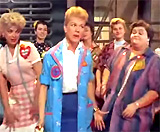  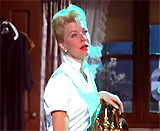  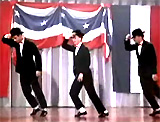 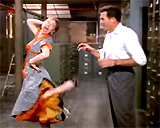 
|
||||||||||||||||||||||||
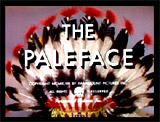
|
The Paleface (1948)
This was a B comedy-western from Paramount Pictures, presented in Technicolor and directed by Norman Z. McLeod. It won its sole Academy Award nomination for Best Original Song, with music and lyrics by Jay Livingston and Ray Evans. Due to its box-office success, there was a sequel titled Son of Paleface (1952), directed by Frank Tashlin. Both films starred:
It was famous for its theme song Buttons and Bows (pictured), the year's Oscar-winning Best Song, sung by Hope (playing a concertina while riding along in a covered wagon) to Russell inside the wagon. |
 
|
||||||||||||||||||||||||

|
Papa's Delicate Condition (1963)
Director George Marshall's family comedy had the tagline: "Follow the Gay Parade" - different in meaning from today. The plot (screenplay written by Jack Rose) was based on silent screen actress/author Corinne Griffith's memoirs, published in 1952, about her life in Texas at the turn of the century with her father. She had acquired the title: The Orchid Lady of the Screen. The film's main characters in the Griffith family were:
The 1962 Jimmy Van Heusen (music) and Sammy Cahn (lyrics) song Call Me Irresponsible won the year's Oscar for Best Original Song (the film's sole nomination). Many others have recorded the song, notably Frank Sinatra, but also Jack Jones and Andy Williams. In the comedy, it was sung by Jackie Gleason (pictured twice), alone at night, drinking and stumbling around in his bedroom in his pajamas, directing the lyrics toward a mannequin (his wife's headless dress dummy):
|
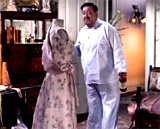 
|
||||||||||||||||||||||||

|
Paramount on Parade (1930) This stylish black and white Paramount production (one of the best examples of an all-star revue of songs and sketches by current and upcoming stars in a studio) was directed by eleven directors. It was created in response to other popular revue films at the time, including:
Its major numbers were:
|
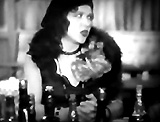   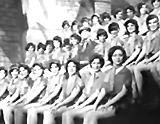
|
||||||||||||||||||||||||
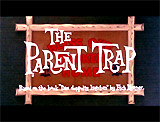
|
The Parent Trap (1961) This Disney Technicolored comedy farce was so popular that it spawned three made-for-TV sequels: The Parent Trap II (1986), Parent Trap III (1989) and Parent Trap: Hawaiian Honeymoon (1989), and the feature film remake The Parent Trap (1998) with Lindsay Lohan (in her film debut). It featured a plot in which two teenaged twins romantically schemed to reunite their divorced biological parents: Mitch Evers (Brian Keith) and Maggie McKendrick (Maureen O'Hara). It was cleverly advertised with trick photography (Oscar-nominated for Best Film Editing) - early split-screen images of its main star Hayley Mills (in her second of six films for the Disney studio), portraying both of the separated-at-birth twins:
Their most memorable song was a duet titled Let's Get Together (pictured). |

|
||||||||||||||||||||||||
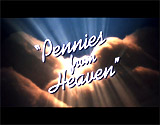
|
Pennies from Heaven (1981) This MGM film was based on the critically acclaimed late 1970s, six-part British BBC-TV mini-series by Dennis Potter - it was set not in London but in Depression-era Chicago and areas of rural Illinois. The two main stars who lip-synched and danced to many 1920s-30s pop songs were:
Numbers included:
Christopher Walken, in a short role as slick pimp Tom, performed a seductive, almost-lewd striptease/tap-dance (to the tune of Let's Misbehave) (pictured thrice) on top of a bar in a sleazy joint to entice "Lulu". |
 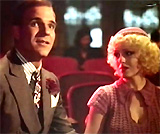   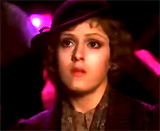 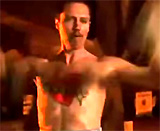
|
||||||||||||||||||||||||

|
Persepolis (2007, Iran/USA/Fr.) This dark autobiographical, coming-of-age film (nominated for Best Animated Feature Film) was about the 1979 Islamic (Iranian) Revolution, based upon Marjane Satrapi's graphic novel. Its most notable sequence was a montage, featuring a humorous, heavily-accented rendition of Frank Stallone's and Survivor's Eye of the Tiger (from the "can-do" film Rocky III (1982)): ("Risin' up, Back on the street...") (pictured). It was portrayed by defiant Iranian political dissident Marjane Satrapi (voice of Chiara Mastroianni) - beginning with her punching fists in the mode of Bruce Lee - after she had returned to a repressive Iran and was freed from heavy medication (after being mis-diagnosed as "depressed"). In the work-out montage, she awoke, punched out three times, showered, removed some unwanted body hair on her leg and karate-kicking like Bruce Lee, then strode into the street and entered the University. The rhythm of the song enervated her to exercise in aerobic-wear (and leg warmers) with others. |
 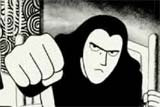 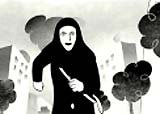 
|
||||||||||||||||||||||||

|
Philadelphia (1993)
Hollywood's first major, big-budget feature film about AIDS was this landmark film (essentially a courtroom drama) by director Jonathan Demme. The film had five Oscar nominations (with two wins) - two of which were for competing 'title songs':
Bruce Springsteen's tear-jerking Oscar-winning song Streets of Philadelphia (pictured) was effectively used in the film, during the opening credits sequence - a flyover and montage of various locations in the city. During the final scene - a reception sequence held in the Beckett home following Andrew's funeral, mourners watched home movies of Andrew's younger days, to the soundtrack's tune of Neil Young's Oscar-nominated Philadelphia (pictured twice). |
  
|
||||||||||||||||||||||||
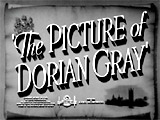
|
The Picture of Dorian Gray (1945) There were many film versions of Oscar Wilde's 1890 novel of the same name, although this MGM production was the most famous. Its familiar tale was about a young, wealthy, hedonistic and handsome Victorian aristocrat Dorian Gray (Hurd Hatfield) in 19th century London, who made a wish that his portrait would age (and show the ravages of sin) instead of himself. In one of the film's earlier scenes, on stage in a cheap English tavern (the Two Turtles pub) in the East End slum area of the city, beautiful Sibyl Vane (Angela Lansbury) performed a plaintive song::
She then reprised the song by walking amongst the patrons, as the manager threw fake snow onto her. One of the customers - Dorian Gray - was entranced by her innocence and her singing. She also was smitten by him, and called him "Sir Tristam" - referring to the name of a mythical, chivalrous knight. He soon fell in love with her and proposed engagement. However, he shortly thereafter cruelly broke off the engagement, causing her to commit suicide. |
  
|
||||||||||||||||||||||||
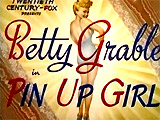
|
Pin Up Girl (1944) During the early 40s (the war years), one of the most popular stars at the film box-office was 20th Century Fox's' 'pin-up girl' -- Betty Grable-- with her famous long-legged gams in a widely-distributed swimsuit photo. Grable starred in a number of entertaining but mindless and escapist musicals such as this Technicolored romantic comedy (named to take advantage of her status) - it turned out to be one of the most lightweight of her many starring vehicles. She took the role of canteen lady Lorry Jones who passed out autographed pin-up photos to the soldiers at the local USO in Missoula, Missouri. In the plot, she also traveled to New York City and to Washington, DC (to be a stenographer), where she became embroiled in romantic complications when she masqueraded as singer Laura Lorraine, a world-famous Broadway star. Grable's most memorable song-dance performances were:
Co-star Martha Raye (as Molly McKay, the star singer at NYC's Club Chartreuse) also performed in a few musical sequences:
|
 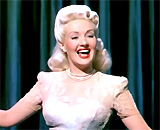   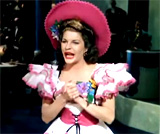  
|
||||||||||||||||||||||||

|
Pink Floyd: The Wall (1982,
UK) Alan Parker's re-imagining of the Pink Floyd musical album incorporated memorable adult-themed animated sequences by cartoonist Gerald Scarfe. The sequences illustrated a descent into madness by burned-out rock singer Pink (Bob Geldorf) in a Los Angeles hotel room - through a series of rambling music video segments.
Memorable scenes included:
|
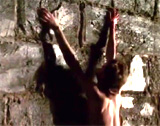 The Wall  The Pain 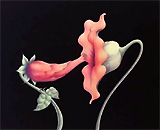 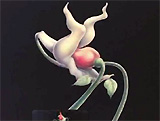 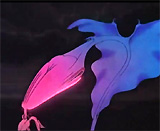 Gerald Scarfe's Botanical Act of Intercourse and Devourment 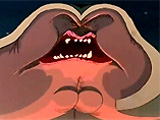   "The Trial" - with Judge Arse  The Exploding Wall |
||||||||||||||||||||||||
(alphabetical by film title) Introduction | A-1 | A-2 | B-1 | B-2 | B-3 | C-1 | C-2 | D-1 | D-2 | E | F-1 | F-2 | G-1 | G-2 H-1 | H-2 | I-J | K | L-1 | L-2 | M-1 | M-2 | N-O | P-1 | P-2 | R-1 | R-2 | S-1 | S-2 | S-3 | T | U-V | W | X-Z |